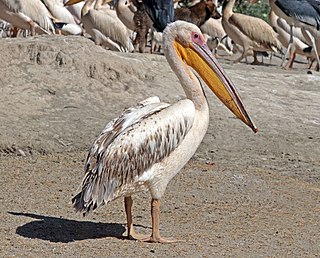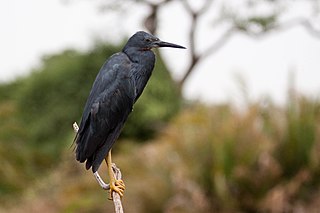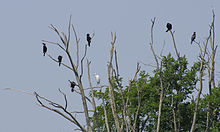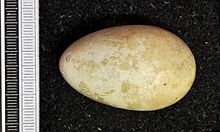
The Danube Delta is the second largest river delta in Europe, after the Volga Delta, and is the best preserved on the continent. The greater part of the Danube Delta lies in Romania, with a small part in Ukraine. Its approximate surface area is 4,152 square kilometres, of which 3,446 km2 (1,331 sq mi) is in Romania. With the lagoons of Razim–Sinoe, located south of the main delta, the total area of the Danube Delta is 5,165 km2 (1,994 sq mi). The Razim–Sinoe lagoon complex is geologically and ecologically related to the delta proper; the combined territory is listed as a World Heritage Site.

Phalacrocoracidae is a family of approximately 40 species of aquatic birds commonly known as cormorants and shags. Several different classifications of the family have been proposed, but in 2021 the IOU adopted a consensus taxonomy of seven genera. The great cormorant and the common shag are the only two species of the family commonly encountered in Britain and Ireland and "cormorant" and "shag" appellations have been later assigned to different species in the family somewhat haphazardly.

Audouin's gull is a large gull restricted to the Mediterranean and the western coast of Saharan Africa and the Iberian Peninsula. The genus name is from Ancient Greek ikhthus, "fish", and aetos, "eagle", and the specific audouinii and the English name are after the French naturalist Jean Victoire Audouin.

The purple heron is a wide-ranging species of wading bird in the heron family, Ardeidae. The scientific name comes from Latin ardea "heron", and purpureus, "coloured purple". It breeds in Africa, central and southern Europe, and southern and eastern Asia. The Western Palearctic populations migrate between breeding and wintering habitats whereas the African and tropical-Asian populations are primarily sedentary, except for occasional dispersive movements.

The Mediterranean gull is a small gull. The scientific name is from Ancient Greek. The genus Ichthyaetus is from ikhthus, "fish", and aetos, "eagle", and the specific melanocephalus is from melas, "black", and -kephalos "-headed".

Ialomița County is a county of Romania, in Muntenia, with the capital city at Slobozia.

The little pied cormorant, little shag or kawaupaka is a common Australasian waterbird, found around the coasts, islands, estuaries, and inland waters of Australia, New Guinea, New Zealand, Timor-Leste, and Indonesia, and around the islands of the south-western Pacific and the subantarctic. It is a small short-billed cormorant usually black above and white below with a yellow bill and small crest, although a mostly black white-throated form predominates in New Zealand. Three subspecies are recognised. Until recently most authorities referred to this species as Phalacrocorax melanoleucos.

The Dalmatian pelican is the largest member of the pelican family, and perhaps the world's largest freshwater bird, although rivaled in weight and length by the largest swans. They are elegant soaring birds, with wingspans rivaling those of the great albatrosses, and their flocks fly in graceful synchrony. With a range spanning across much of Central Eurasia, from the Mediterranean in the West to the Taiwan Strait in the East, and from the Persian Gulf in the South to Siberia in the North, it is a short-to-medium-distance migrant between breeding and overwintering areas. No subspecies are known to exist over its wide range, but based on size differences, a Pleistocene paleosubspecies, P. c. palaeocrispus, has been described from fossils recovered at Binagady, Azerbaijan.

The great white pelican also known as the eastern white pelican, rosy pelican or white pelican is a bird in the pelican family. It breeds from southeastern Europe through Asia and Africa, in swamps and shallow lakes.

The Eurasian spoonbill, or common spoonbill, is a wading bird of the ibis and spoonbill family Threskiornithidae. The genus name Platalea is from Latin and means "broad", referring to the distinctive shape of the bill, and leucorodia is from Ancient Greek leukerodios "spoonbill", itself derived from leukos, "white" and erodios "heron". In England it was traditionally known as the "shovelard", a name later used for the Northern Shoveller.

The common scoter is a large sea duck, 43–54 cm (17–21 in) in length, which breeds over the far north of Europe and the Palearctic east to the Olenyok River. The genus name is derived from Ancient Greek melas, "black", and netta, "duck". The species name is from Latin niger "shining black". The black scoter of North America and eastern Siberia is sometimes considered a subspecies of M. nigra.

The Sandwich tern is a tern in the family Laridae. It is very closely related to the lesser crested tern, Chinese crested tern, Cabot's tern, and elegant tern and has been known to interbreed with the lesser crested. It breeds in the Palearctic from Europe to the Caspian Sea wintering to South Africa, India and Sri Lanka.

The little cormorant is a member of the cormorant family of seabirds. Slightly smaller than the Indian cormorant it lacks a peaked head and has a shorter beak. It is widely distributed across the Indian Subcontinent and extends east to Java, where it is sometimes called the Javanese cormorant. It forages singly or sometimes in loose groups in lowland freshwater bodies, including small ponds, large lakes, streams and sometimes coastal estuaries. Like other cormorants, it is often found perched on a waterside rock with its wings spread out after coming out of the water. The entire body is black in the breeding season but the plumage is brownish, and the throat has a small whitish patch in the non-breeding season. These birds breed gregariously in trees, often joining other waterbirds at heronries.

The slaty egret is a small, dark egret. It is one of the species to which the Agreement on the Conservation of African-Eurasian Migratory Waterbirds (AEWA) applies. It is classified as Vulnerable, the biggest threat being habitat loss.

The Socotra cormorant is a threatened species of cormorant that is endemic to the Persian Gulf and the south-east coast of the Arabian Peninsula. It is also sometimes known as the Socotran cormorant or, more rarely, as the Socotra shag. Individuals occasionally migrate as far west as the Red Sea coast. Despite its name, it was only confirmed in 2005 that it breeds on the Socotra islands in the Indian Ocean.

The crowned cormorant or kuifkopduiker, 'Fringe-head diver', is a small cormorant that is endemic to the waters of the cold Benguela Current of southern Africa. It is an exclusively coastal species and is not found more than 10 km (6 mi) away from land. This species is related to the reed cormorant, and was formerly considered to the same species.
Romania's landscape is almost evenly divided among mountains, hills, and plains. These varied relief forms spread rather symmetrically from the Carpathian Mountains, which reach elevations of more than 2,400 metres, to the Danube Delta, which is just a few metres above sea level.

The Balta Mică a Brăilei Natural Park is a protected area which is situated in Romania, in Brăila County, on the administrative territory of communes Berteștii de Jos, Chiscani, Gropeni, Mărașu and Stăncuța.

Labudovo okno is a special nature reserve and a Ramsar site in Serbia.

The fauna of Romania comprises all the animal species inhabiting the country of Romania and its coastal territory in the Black Sea.
























